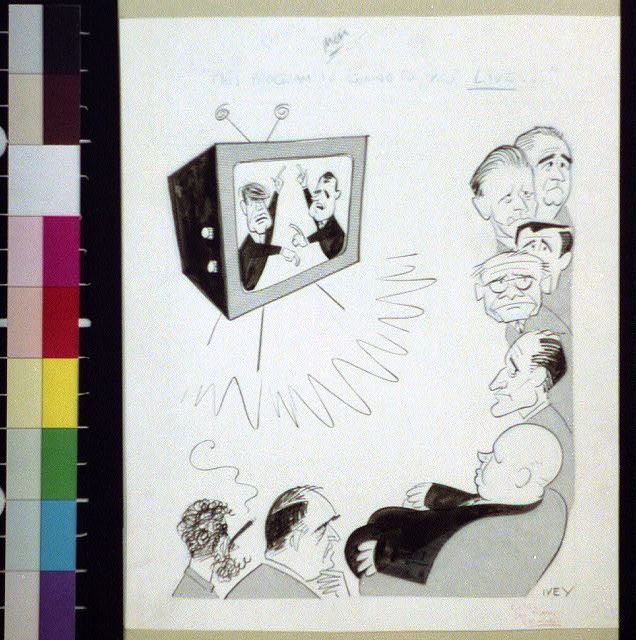
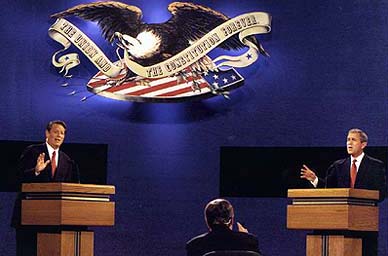
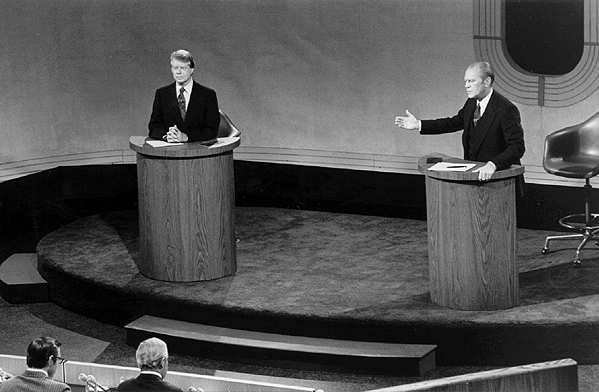
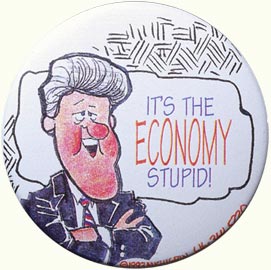
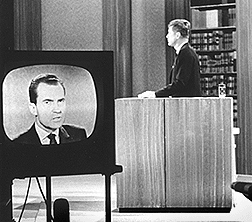
Richard Harless
History 696
Prof. Rosenzweig
Dec. 13, 2004
The confrontation between Kennedy and Nixon would change politics forever.
~Theodore White, The Making of the President 1960
The presidential election campaign of 1960 signified a political watershed. It was the first campaign in which the candidates of the two major parties appeared together in a series of televised debates. The fact that both candidates agreed to appear on these “Great Debates” constituted recognition by politicians at the highest level in both major political parties of the power of a medium that had only been available to most Americans for less than ten years.
The Great Debates acknowledged a revolution that had taken place in America’s living rooms. According to the census of 1950, only 4,400,000, or 11 per cent, of American families owned television sets. By 1960 that number had exploded to 40,000,000, or 88 per cent. 1 Unfortunately for those in the television business, the general perception was that its enormous potential to educate and enlighten had been wasted. Shortly after the 1960 campaign, TV was labeled a “vast wasteland” by the Chairman of the Federal Communications Commission (F.C.C.) Because television had made “image” so important during the 1960 campaign, it was perhaps ironic that the medium’s own image needed burnishing. The Great Debates were an attempt to improve that image by providing a valuable public service. It would enable American voters for the first time to view their potential leaders together in an arena in which both would be required to respond spontaneously to questions of which they had no prior knowledge.
In order to televise the debates, the TV networks first had to leap the legal hurdle that was the so-called “equal time” provision of federal communication law. This law would have required the networks to provide a debate forum not only for the major party candidates, Richard Nixon and John F. Kennedy, but the dozen other candidates from splinter parties that were running for president. Congress responded to intense network lobbying by temporarily suspending the equal time requirement for the 1960 campaign only.
This paved the way for a series of four weekly debates that would require the candidates to make opening and closing remarks and to respond to questions from a panel of four newsmen. The first debate occurred on September 26, 1960 and in the words of political historian, Theodore H. White, “the confrontation between Kennedy and Nixon would change politics forever.” During the day of the debate Kennedy had been resting and preparing for his TV appearance as if he was cramming for a college exam, whereas Nixon, confident of his debating skills, had spent the day campaigning. For the debate Nixon was dressed in a gray suit that blended in with the background of the set and looked haggard and tired. Kennedy looked tanned and fit and his dark suit contrasted well with the background. Although both men performed creditably in terms of the substance of what they were saying, the visual disparity between the two was stunning. Before an estimated audience of 70 million Americans, Kennedy appeared cool and in total command whereas Nixon appeared nervous and unsure of himself. Kennedy addressed the television audience whereas Nixon, in debating style, addressed Kennedy. A telling sidebar was that polls showed that for radio audiences the debate was a tie but for TV audiences, Kennedy was the clear winner.
Though there would be three more debates in which Nixon improved both his appearance and his preparation, it was the first debate that set the tone and many political observers believed that it also set the stage for Kennedy’s victory. Post-election polls showed that six percent of the voters acknowledged that the debates influenced their decision. Since Kennedy’s winning margin was razor-thin, it is not unreasonable to conclude that his debate performances were the key to victory. Immediately after the election, Kennedy himself stated that, “It was TV more than anything else that turned the tide.” 2
Not surprisingly this lesson was not lost on future candidates. So profound was the perceived impact of the Great Debates on the election results that it would be sixteen years before candidates would again dare stepping into the television arena. In 1964, Lyndon Johnson had such an overwhelming lead over Barry Goldwater that he had no reason to risk appearing in TV debates. In 1968, Nixon and Hubert Humphrey were evenly matched but Nixon’s searing experience in 1960 barred any serious consideration for him of another possible TV calamity. In 1972, Nixon had a commanding lead over George McGovern so again there was no basis for risking a joint appearance with his opponent. It has begun to appear that the 1960 debates had been a one-time occurrence.
By 1976,however, the equal time rule had been overturned by the F.C.C. and both Gerald Ford and Jimmy Carter, locked in a closely contested election, agreed to a series of joint appearances. The power of the debates to influence elections was again demonstrated with Ford’s inexplicable assertion that Eastern Europe was not under Soviet domination. That gaffe may have led to his defeat. Since 1976, TV debates have become a permanent feature of the election landscape. It is hard to underestimate the value of the debates for voters who have the opportunity to compare the views and the performance under fire of the two men who seek to lead them for four years. Many would argue that television is even more of a “wasteland” today than it was 44 years ago but every four years, it performs the same invaluable public service that was first in evidence in 1960.
This website seeks to provide a teaching resource for examining the history and significance of television debates. Although there is almost no limit to the amount of debate source material available on the web, the chief contribution of this site is to provide a "one-stop shopping" debate site for teachers and students with a series of detailed lesson plans and the relevant primary sources. The home page includes internal links to the history of the debates, candidate biographies, debate transcripts, debate video excerpts, and lesson plans. This proposal includes an "Introduction," the "Scope and Genre" of the site, a "Rationale" for using a digital format, a description of the "Structure" of the site, a "Technical Plan," and a "Conclusion." (Navigation between the pages is accomplished using the internal links at the bottom of each page.) 1 Theodore H. White. The Making of the President 1960 (New York: Atheneum House, 1961), 335.
2 Ibid., 353.